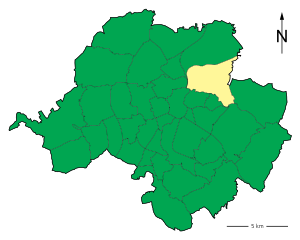Chemnitz-Hilbersdorf
|
Hilbersdorf district and statistical district No. 15 of Chemnitz |
|
|---|---|
| Coordinates | 50 ° 51 '35 " N , 12 ° 57' 11" E |
| surface | 9.38 km² |
| Residents | 6801 (Dec. 31, 2013) |
| Population density | 725 inhabitants / km² |
| Incorporation | Apr 1, 1904 |
| Post Code | 09113, 09130, 09131 |
| prefix | 0371 |
| Transport links | |
| Federal road |
|
| tram | formerly 8, 9 |
| bus | 21, 32, 66, N11 |
Hilbersdorf is a district in the east of Chemnitz on the northern edge of the Zeisigwald . The district was incorporated on April 1, 1904. The federal highways 169 and 173 lead through Hilbersdorf . The rural district of Ebersdorf connects to the northeast .
history
Hilbersdorf was created during the German expansion to the east, when the Ore Mountains were opened up by German settlers. Hilbersdorf was first mentioned in a document in 1290 as Hillebrandisdorff ("Village of a Hildebrand"). In another document from 1540 the place is called Hilberschdorf . The old town center with the Katharinenkirche, built in the 16th century, was demolished in favor of the construction of the track systems for the Chemnitz-Flöha railway line from 1863 to 1866. The Trinitatis Church , consecrated in 1866, was built for the Katharinenkirche on Frankenberger Straße .
The place kept its rural structure until the 18th century. Only then, aided by the industrial development of nearby Chemnitz, did the economic structure change. The mining of the Hilbersdorfer Porphyrtuff (correct: a tuff of an Ignimbritic sequence) in the adjacent Zeisigwald was of great importance . Favored by this, a center of the stonemasonry developed in the 19th century, which experienced a boom around 1870. Its cut stones were mainly used in industrial and residential construction in and around Chemnitz. After 1945, however, this dismantling came to a standstill.
At the time when Hilbersdorf was being built towards the city of Chemnitz, silicified trunks were found. They were preserved by solidified volcanic ash. The Orth monument (at the intersection of Zeißstrasse and Orthstrasse ), named after August Orth , the Berlin architect who, as the landowner of this site, which was built on from 1870 to 1900, gave the city of Chemnitz as a gift , reminds of this find .
On January 26, 1914, the “Schnell Markt” was incorporated into Ebersdorf. In this way, housing developments that had become necessary could also be built here. Today, this area and part of Hilbersdorf north of the railway bridge on the Chemnitz-Dresden line, due to the reorganization of the city districts after reunification, belong to Ebersdorf again.
Attractions
From 1902, Hilbersdorf was home to one of the largest marshalling yards in the German Empire . Here you could experience an extraordinary shunting technique in action: instead of locomotives, the freight trains were moved using a rope pay-off system. Associated with this was an extraordinary background noise. For safety reasons, there was a constant "tinkling" emanating from the flat wagons of the rope pay-off system moving between the rails. An important sight in this context is the Saxon Railway Museum . The marshalling yard was closed in 1996, only the stop of the same name on the Dresden – Werdau railway line is still in operation today.
Hilbersdorf is known as the main site of the " Chemnitz Petrified Forest ". During a volcanic eruption about 290 million years ago, trees within a radius of 10 kilometers were preserved by the ash rain and silicified over millions of years.
A branch of the old salt route from Halle via Leipzig and Chemnitz to Prague probably led through Hilbersdorf.
The cannonball house is interesting. Two bullets attached to the front of an old house at Frankenberger Straße 156 bear witness to the clash on October 14, 1813 between Russian and French troops on the way to the Battle of Leipzig. However, the bullets did not hit the house, they were found in fields that were turned over.
Also in Hilbersdorf from 1975 to July 17, 1991 was the "Panzer", a disused T 34 of the Red Army with a cannon muzzle directed towards the city, which was supposed to commemorate the liberation from Hitler's fascism. In 1980 the attempted demolition of this tank by Josef Kneifel caused a sensation.
Personalities
- Ernst Castan (1871–1948), politician and member of the Saxon state parliament
- Wilhelm Rudolph (1889–1982), painter, graphic artist and draftsman
- Hans Helfritz (1902–1995), composer, writer and photographer
literature
- Richard Steche : Hilbersdorf. In: Descriptive representation of the older architectural and art monuments of the Kingdom of Saxony. 7th issue: Amtshauptmannschaft Chemnitz . CC Meinhold, Dresden 1886, p. 43.
Web links
- Hilbersdorf in the Digital Historical Directory of Saxony




